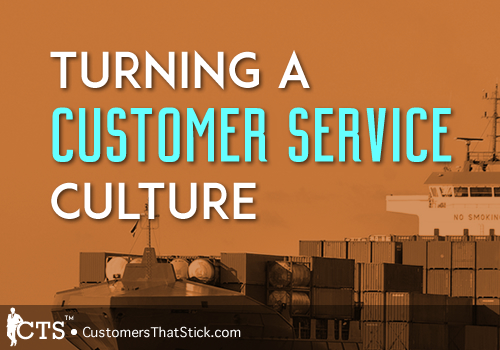We wish that changing a customer service culture could be like turning a Jet Ski®.

We slam the steering handles hard to the side, the Jet Ski® turns around almost on a dime, and within moments, we are speeding the other way at full speed. Sure, the turn is tough, and the sudden motion jerks both body and watercraft hard, but for a short, intense effort we are rewarded with a quick and complete turnaround.
We all wish that changing a customer service culture happened that way. Unfortunately, it doesn’t.
Changing a a customer service culture, particularly in a large organization, is more akin to turning around a container ship. Take a look at the following graphic from ShipsBusiness.com. Note the slow wide path the ship must take to head in the other direction. In fact, notice that it has to “swing wide” to even begin to change direction.

Cultural change is like this. It can not be accomplished with a hard jerk of the wheel; it must be carefully and strategically planned and executed.
In How Customer Service Can Save Cable, we spoke about Comcast’s plan to turn around its customer service. Whether you have faith in Comcast or not (and some commenters on the syndicated version of that post expressed doubt), Comcast’s framework for change seems substantive on the surface. The sheer size of the change planned also shows how hard it is to turn a customer service culture.
Let’s look at what Comcast is doing as part of its turnaround plan (list from Fortune.com):
- Adding three new call centers
- Hiring 5,500 new workers over the next three years
- Earmarking $300 million for overhauling customer experience beyond the new hires
- Creating an app that lets customers track and rate technicians
- Giving a $20 credit when a technician is late or doesn’t show up
- Retraining 84,000 employees to become more customer-centric
- Changing the way it incentivizes workers who deal directly with consumers
While a number of the items above deal with the structural aspects of customer service, making sure there are adequate resources in place to deliver the service, cultural change might be even harder. Sure, the first step in cultural change is making sure the structural and operational requirements needed to support a new customer-centricity are in place; however, turning around a culture that has not been customer focused for many years makes the structural aspects seem almost easy by comparison.
How hard is cultural change? Have you ever tried to change one mind? Have you ever tried to change your own habits? How about someone else’s habits?
Try that writ large across tens or hundreds of thousands of employees. It is no easy task.
Cultural change is extremely complex, but at it’s most basic level, I would say any cultural change requires at minimum the following two ingredients: having a mission employees can believe in and a reason to change.
The mission must matter. It is not enough to say that we need to be better at customer service; organizations must convey the why to frontline teams so that they understand the importance of the new direction. They need to know that what they are going to do matters and that it is a better way than the old one.
Having a reason for change is also crucial. In the case of Comcast, the bad press it’s received around its customer service in recent years can can actually be used to its advantage . Do you think Comcast’s employees like being associated with such a reputation? Do you think they like telling new acquaintances where they work and getting snide comments or outright complaints in reply? Comcast’s employees have a ready-made reason for change, and that is crucial to making one.
Turning a customer service culture is no easy task. In addition to the above two prerequisites, it requires strategies around internal communication, external communication, and executive buy-in, to name a few.
It is also important to keep in mind that customer’s don’t care that you’re turning a container ship; they expect the Jet Ski®. Your strategy should take this into account.
Finally, in any cultural change, it is actions that speak loudest of all. In organizations, resources and focus go to what’s important. You cannot turn a customer service culture with a memo and “we love our customers” coffee mugs; you can and must take the long, hard path of change and commit the organization to the new direction at all levels. It is only then that you can get the ship turning in another direction.
This article was syndicated from Business 2 Community: Turning A Customer Service Culture
More Sales & Marketing articles from Business 2 Community:
- Content Marketing Questions — How To Do Marketing With No Budget?
- Hello Content Marketing, Goodbye Ads…Sort Of
- How To Create A Thought Leadership Strategy That Supports True Innovation
- 3 Vital Marketing Stacks For The Marketing Technologist
- How To Choose The Right Marketing Automation Solution For Your Business




